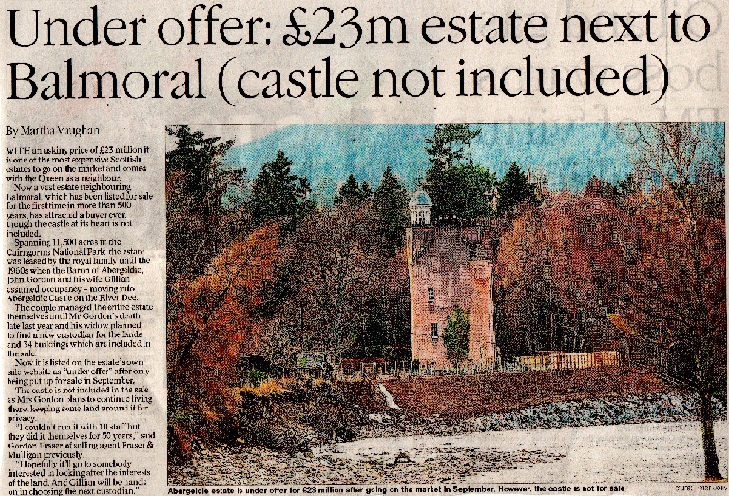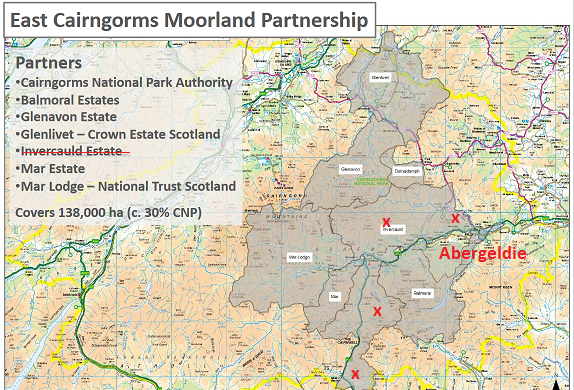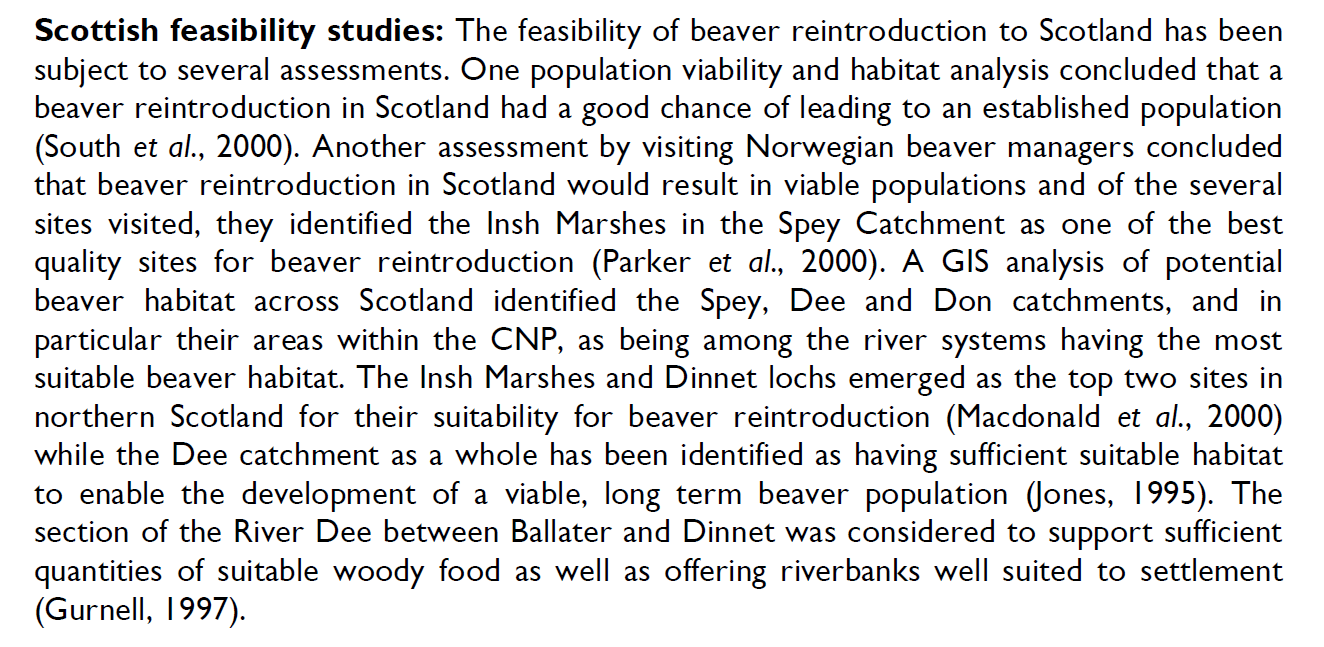
As a campaigner who is trying to change how Scotland’s two National Parks are managed, I am always pleased when posts are picked up by the mainstream media. I never expected my blog on the Royal Family and COP26 (see here) to end up on the front page of the Scottish edition of The Times (and to be given further coverage after that) but perhaps I should have done. This year the Times has run a number of critical articles about how the Royal Family is managing their land, including a poll which showed public support for rewilding Balmoral (see here) and a call from Chris Packham for Balmoral to bring back beavers (see here).

Two days after my post on Abergeldie (see here), the Herald ran an article on the estate sale. This made no mention of the long history of land mis-management by the Royal Family at Abergeldie but it did remind me that the castle had almost been swept away in the floods of 2015. I had not said anything about this when commenting how the Ballater Flood Protection Plan had failed to address the contribution of the extensive muirburn in Glen Girnock to the terrible flooding below.
That was an important omission. Vegetation cover and land-use makes a significant difference to how quickly water runs off the hill and the Girnock drains into the River Dee not far above Abergeldie Castle. While in Scotland there has been little technical research into the impact of muirburn as such on flooding – the word “flood” appears just once in the Werritty Review on Grouse Moor Management – the contribution of bare peat to water run-off has been established (see here). The striking fact I had missed is that even after their own castle was nearly swept away, the Gordons and the Royal Family carried on with muirburn for sporting purpose regardless.
The voluntary approach to conservation in the Cairngorms National Park
After what happened at Abergeldie Castle, it is reasonable to ask whether any natural disaster or anything that anyone could ever say would prompt the Royal Family to change their sporting mindset? Would 1000 people protesting outside Balmoral prompt any reflection?Had the bridge at Balmoral been swept away, would it make any difference? How about a royal prince caught in a landslip? Far from being leaders, it appears that the Royal Family are as stuck in their thinking as King Canute was trying to resist the waves.
This has important implications both for the Cairngorms National Park Partnership Plan and the Scottish Government’s interminable deliberations about how to reform the management of grouse moors and red deer in Scotland. What Balmoral shows is that voluntary measures and partnership working are never going to work with some landowners.
The Cairngorms National Park Authority (CNPA)’s attempts to improve moorland management through the East Cairngorms Moorland Partnership (ECMP) have been an almost complete waste of time and resources. Rather than having to consider all the evidence for this failure, most of which has been kept secret,all you need to do is consider the ECMP estate map:

While Invercauld (red crosses) departed from the ECMP after yet another poisoned eagle (see here), cutting the partnership area in two, there was another huge hole in the ECMP from the very start; Abergeldie. So why would the Royal Family, who hold the sporting rights at Abergeldie and manage the moorland there, not want some of the closest driven grouse shooting to Balmoral to be in the ECMP? Why pretend to apply conservation principles to some parts of the land you manage but exclude others? The hypocrisy runs deep.
None of this farce has stopped the CNPA from including a further commitment to the ECMP in its draft National Park Partnership Plan (NPPP):

Needless to say, no analysis is provided in the NPPP of what the ECMP has achieved or what needs to change now Invercauld has left. The only reasonable conclusion is that the ECMP is a front for traditional sporting interests. The National Trust for Scotland who manage Mar Lodge Estate would be as well getting out and applying to join Cairngorms Connect.
The failure of the Royal Family to change or offer any leadership should tell the Scottish Government that if it serious about putting an end to the environmental destruction caused by traditional sporting estates, it needs – gently but ever so firmly – to give them no choice. Shooting can continue – indeed stalking has an important role in reducing deer numbers to levels where the land and other species will recover – but muirburn and other practices associated with intensive grouse moor management need to be banned. And alongside that the maximum density for deer in the uplands should be set at three per kilometre. This is the level at which it has been shown nature starts to regenerate.
Beavers at Balmoral?
Last week the new Green Minister, Lorna Slater, ended another farce, did the sensible thing and responded to public pressure by agreeing that beavers can now be translocated across Scotland rather than being culled. With the legal barriers to translocation removed, there is a massive opportunity for the Royal Family to show the lead to other landowners and offer up land for beavers at Balmoral as Chris Packham suggested.
Almost exactly five years ago I blogged about the failure of the Cairngorms National Park Authority to include beaver introduction in their last National Park Partnership Plan which was then out for consultation (see here). My post included this extract from a report to the CNPA on re-introductions to the Cairngorms:

Lorna Slater take note! Of all the places Scotland, the best habitats for beaver reintroduction lie within the Cairngorms National Park in the catchments of the Spey, Don and the Dee.

Unsurprisingly, the draft CNPA NPPP is as vague as ever on species re-introductions and provides another example of how our National Park Authorities are almost completely under the thumb of the civil servants. But this was drafted before the Scottish Government were forced into their U-turn on beavers and there is real opportunity now for the CNPA to take the initiative. The case is clear as NatureScot’s Chief Executive Francesca Osowska said in the news release (see here) announcing the translocation U-turn:
“This is a significant step to restore Scotland’s biodiversity and respond to the climate emergency. Up to now, our ability to move, or translocate, beavers to different areas across Scotland has been limited to moving animals within their current range where populations are already established. Being able to move beavers out of their current range gives us a much wider scope.”
The unstated problem is that without co-operation from landowners, scope may be limited and change very slow. The importance of the Royal Family therefore taking a lead on this couldn’t be clearer. A good way for the Royal Family to restore their credibility would be for them to announce that they would welcome beavers being translocated to suitable locations on their own land.
At the same time they could commit to extending those suitable areas by reducing deer numbers and stopping muirburn so that riparian woodlands recover across their estates. That would be a major first step towards the regeneration of the land at Balmoral, Abergeldie and Delnadamph.
Prince Charles is President of WWF (see here). I have emailed WWF Scotland twice about how Prince Charles manages the royal land, the first time a year ago, the second last week. So far I have not received an answer. If you agree its time the Royal Family started to show a lead, you could do worse than call on WWF to ask Prince Charles to support the reintroduction of beavers at Balmoral. Our NGOs alongside our public authorities need to stop doffing their caps to the Royal Family and start acting on principle.

I appreciate this article Nick. Well done. Public funds are tapped by estates for their ‘land management’ activities, then public funds are tapped again to clean up the mess they contribute to.
Good one Nick. Keep at `em. The NP is so disappointing in its actions and policies.